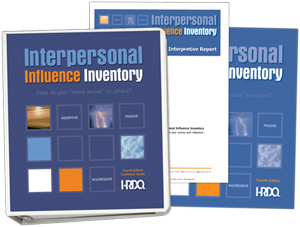 INTERPERSONAL INFLUENCE INVENTORY
INTERPERSONAL INFLUENCE INVENTORY
Available in both Online and Paper-Based Format
The Interpersonal Influence Inventory is a communication assessment for employee and management development training that identifies 1 of 4 influence styles and helps individuals improve their assertive communication skills improved personal, leadership, and organizational performance.
Research shows that assertive behavior improves individual and organizational performance. But individuals are not born assertive – influencing people is an acquired skill. The Interpersonal Influence Inventory is an assessment that has helped thousands of professionals assess their personal influence style, learn how they “come across” to others, and work toward becoming more effective communicators.
Based on an assertive behavior model, the Interpersonal Influence Inventory measures Openness of Communication and Consideration for Others. Combining the two dimensions results in four different individual influence styles: Open Aggressive Behavior, Concealed Aggressive Behavior, Assertive Behavior and Passive Behavior.
Learning Outcomes
- Identify their preference for one of 4 personal influence styles: Passive, Assertive,
- Openly Aggressive, or Concealed Aggressive
- Learn why assertive behavior is the one style that always yields positive results
- Understand how other influence styles can hamper interpersonal communication
- Discover the behavioural cues that signal each style
Theory and Development
The core of the Interpersonal Influence Inventory is derived from leadership and persuasive communication literature. The literature suggests that direct expression of one’s views, coupled with consideration for others, can help improve individual and organizational functioning. When one attempts to influence another, two dimensions of behavior produce an influence style. The dimensions of behavior are openness in communication and consideration for others.
Openness in Communication:
Openness is an individuals’ willingness to disclose to another his or her thoughts, feelings, past experiences, and reactions. People are willing to disclose information about themselves to varying degrees. At one end of the spectrum are people who disclose very little, playing their cards “close to the vest.” At the other end are people who speak their thoughts and feelings directly and fully.
Consideration for Others:
Consideration means an individual’s willingness to accord to others the same rights he or she expects for him- or herself. At one extreme are people who have very little respect for the opinions, feelings, and reactions of others. At the other extreme are people who defend and attempt to preserve the rights of others as strongly as they do their own.
The amount of openness and consideration that people show in their behavior determines the influence style they use. Depending on the relative use of openness and consideration, one of four influence patterns or styles results:
- Openly Aggressive Behavior: “I boldly insist that my rights and needs prevail.”
- Assertive Behavior: “I clearly expresses that everyone has rights and needs.”
- Concealed Aggressive Behavior: “I subtly make sure that my rights and needs prevail.”
- Passive Behavior: “Others’ rights and needs take precedence over mine.”
Uses for the Assessment
It can be used as a standalone training instrument, or it can be incorporated into a more comprehensive program on communication or leadership. It also makes an effective component in training programs for a variety of topics, including coaching, management, and supervisory skills.
How It Works
The Interpersonal Influence Inventory starts with a self assessment that takes individuals approximately 20 minutes to complete. Individuals respond to 40 statements relating to communication and influence, selecting one of five choices ranging from Complete Uncharacteristic to Completely Characteristic of their behavior. The result is the identification of one of four personal influence styles: Openly Aggressive Behavior, Assertive Behavior, Concealed Aggressive Behavior, or Passive Behavior.
If you intend to use the Interpersonal Influence Inventory in a classroom training session, we recommend you allow approximately 40 for interpretation of scores, topic discussion, debrief, and action planning. The Interpersonal Influence Inventory Facilitator Guide includes everything you need to lead a successful training session from comprehensive background information and activities, to reproducible handouts and even a professional PowerPoint presentation. The Facilitator Guide also offers an easy-to-follow workshop outline that expands the Interpersonal Influence Inventory into a 2½ hour program.
What to Order
The Interpersonal Influence Inventory is available in both Online and Print Versions.
The Online Version is an excellent choice for enterprise-wide training or audiences that are geographically dispersed. It offers 24/7 access, streamlined distribution, and instant scoring. Each Online Assessment includes personalized reporting, full-colour charts, interpretive information, worksheets, and action planning.
The Print Version is ideal for facilitators who prefer to oversee scoring and administration of the assessment, if you don’t know who the participants will be before the class begins, or if your learners do not have easy access to computers. Includes pressure-sensitive forms for scoring to aid manual tabulation. The accompanying Participant Guide includes interpretive information, worksheets, and action planning.